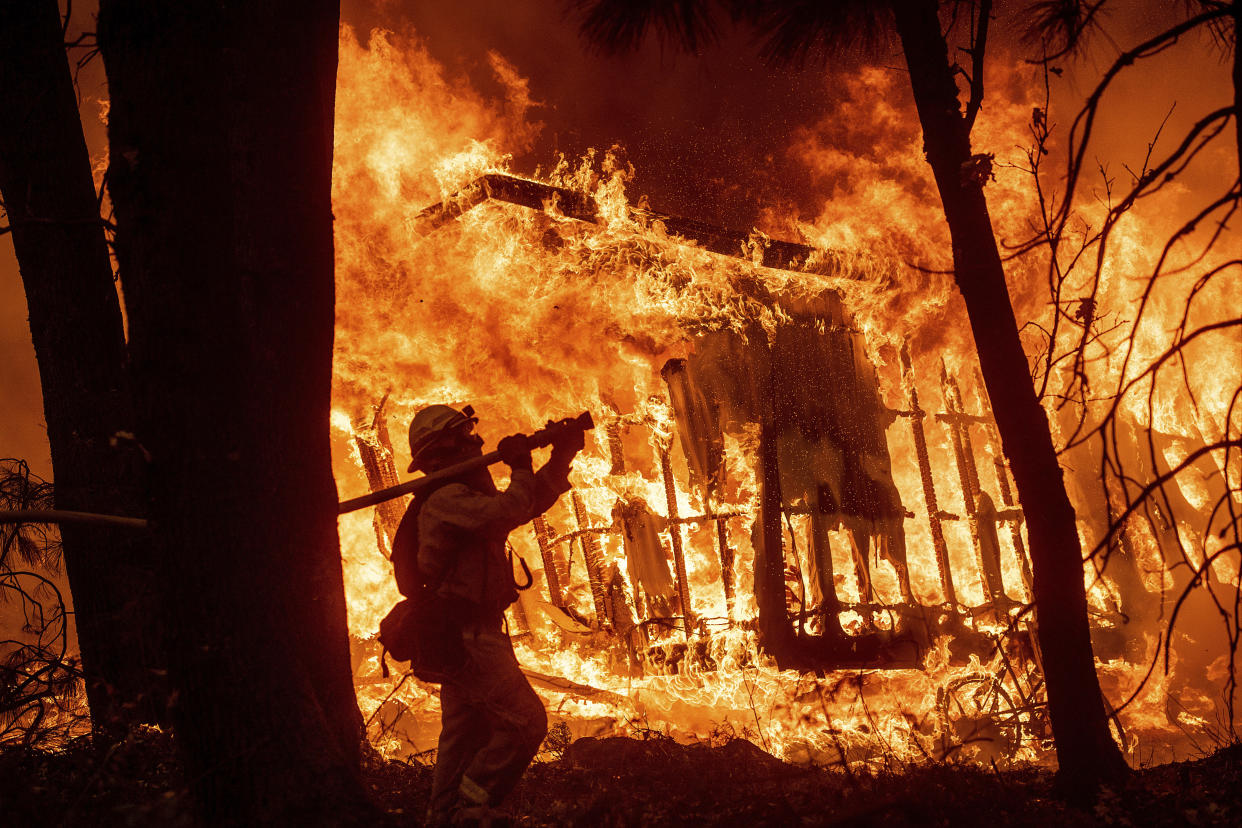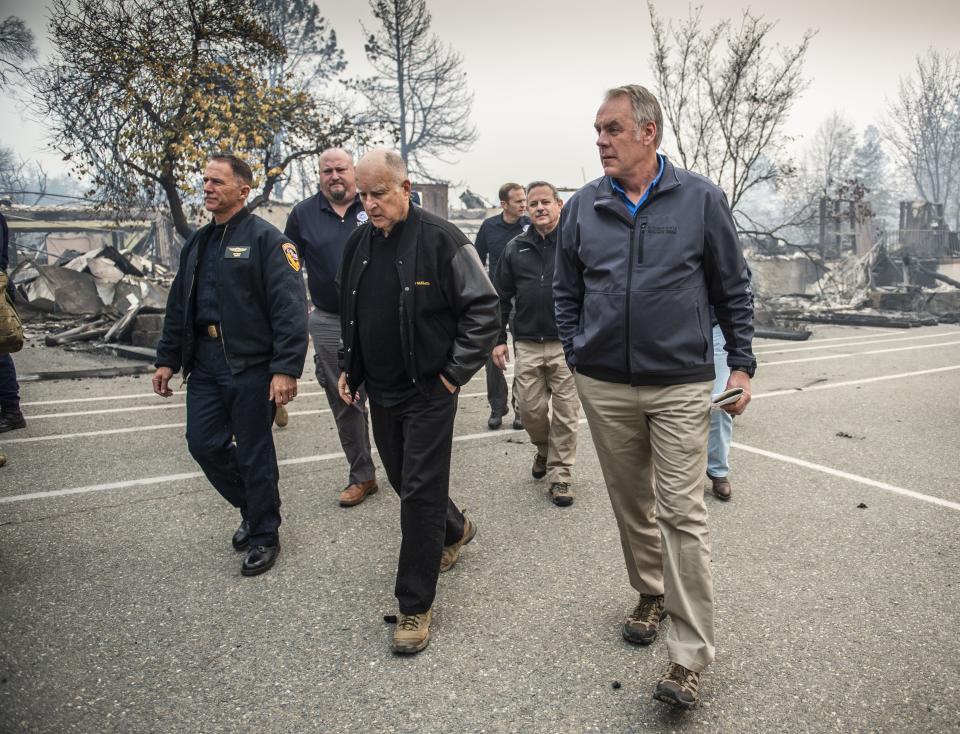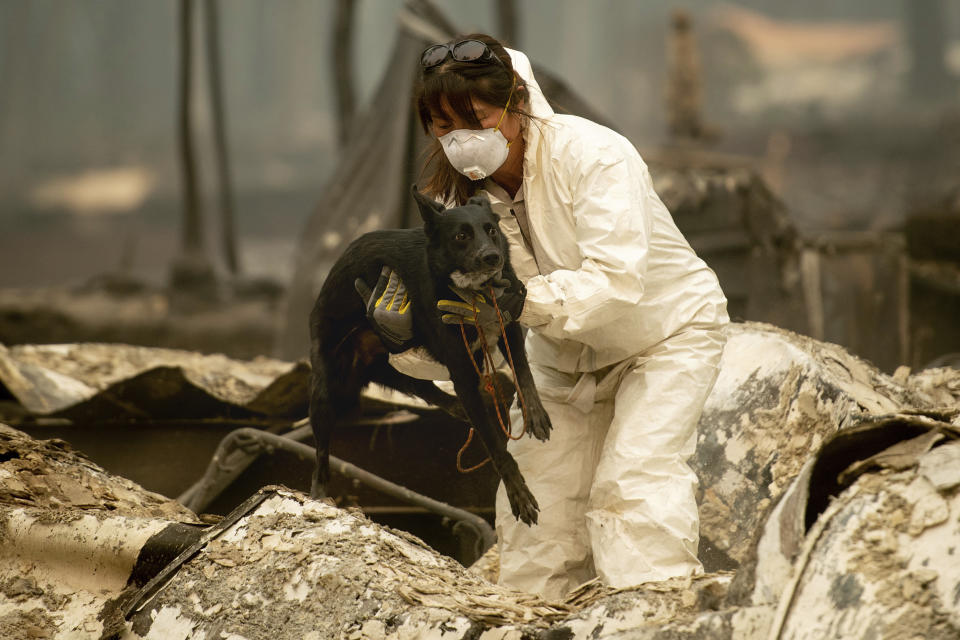As California fights wildfires, political tempers cool: 'We're in for very difficult times'

The Trump administration’s disagreements with California over environmental policy are well-known, but the bickering is on hold while both parties work to contain the devastating wildfires and prepare to deal with the aftermath.
California Gov. Jerry Brown and Interior Secretary Ryan Zinke toured areas ravaged by the Camp Fire in Northern California on Wednesday before addressing the media together at a wildfire response base in Butte County. Both acknowledged that many factors contribute to the state’s wildfire problem and refrained from blaming specific policies — or the opposing party.
“There are many elements to this,” Brown said. “What causes these kinds of catastrophes, where people live and how they live and the structures, the changing of the climate, the winds, the dryness and all the rest of it, and the continuing drought. We’re in for very difficult times. It will never be the same.”
Zinke acknowledged that wildfires are getting worse, and agreed that many variables play a role, but did not mention climate change.
“As the governor said, there’s a lot of reasons for a fire. Now is really not the time to point fingers. Now’s the time to look at the infrastructure. Make sure we have accountability for who’s out there who’s unaccounted for. Deal with the families and make sure they have what they need,” Zinke said.

Zinke and Brown strongly disagree about the relationship of global warming to the spate of wildfires. Brown is one of the loudest voices in politics sounding the alarm about climate change. For his part, Zinke blames forest-management policies promoted by “radical environmentalists” who oppose thinning forests by cutting down trees. He even told Brietbart Radio that “environmental terrorist groups” are mostly responsible for wildfires.
But the disagreements were not on display in their comments to the media after surveying the devastation of the most destructive and deadly wildfire in California’s history. The Camp Fire, which started early Nov. 8 and is still only 35 percent contained, obliterated the town of Paradise, which had a population of 26,682, and incinerated 138,000 acres. At least 56 people were killed and 130 people are missing — most of them senior citizens. The fire destroyed at least 8,756 homes and 260 commercial buildings.
President Trump’s initial reaction to the California wildfires was to blame forest mismanagement, without acknowledging that the federal government owns more than half of the state’s forests. Although criticized for failing to acknowledge the role of climate change — and for offering baseless theories in the past — Trump is correct in saying that years of poor forestland management is a major factor.
Regardless, as the full scope of the devastation came into view, Trump backed off full-throated denunciations and struck a more conciliatory tone.
Was just briefed by @FEMA_Brock and @SecretaryZinke, who are in California. Thank you to the great Firefighters, First Responders and @FEMA for the incredible job they are doing w/ the California Wildfires. Our Nation appreciates your heroism, courage & genius. God Bless you all!
— Donald J. Trump (@realDonaldTrump) November 14, 2018
Just spoke to Governor Jerry Brown to let him know that we are with him, and the people of California, all the way!
— Donald J. Trump (@realDonaldTrump) November 14, 2018
White House deputy press secretary Lindsay Walters said Thursday that Trump plans to visit California on Saturday “to meet with individuals impacted by the wildfires.”
Authorities attribute the death toll, which will likely rise, to how quickly the whipping wind spread the flames through Paradise. National Guard troops are looking for the remains of the missing Paradise residents.
Brown and Zinke agreed that the devastation wrought by the Camp Fire is the worst they have ever seen. Zinke, a Navy SEAL veteran, even called the destruction in Paradise “worse than any war zone I saw in Iraq.”
Meanwhile, the Woolsey Fire, which scorched parts of Malibu, killed three people and charred 98,362 acres. It’s 57 percent contained. The Hill Fire, which burned 4,531 acres in Ventura County, about 60 miles northwest of Los Angeles, is 97 percent contained.
At the press conference, Chief Ken Pimlott, the director of the California Department of Forestry and Fire Protection (Cal Fire), said the more than 9,000 firefighters engaged in the firefights throughout the state are working to use the resources at their disposal strategically.
“Right now, we are focused on maintain the pace and the battle rhythm of this firefight across the state to make sure we have all the resources we need and that we have them in the right places,” Pimlott said.
As of Thursday morning, Cal Fire had deployed 1,202 fire engines, 121 earthmovers, 46 helicopters and several air tankers. Additional resources were contributed by other states.
Experts say wildfires are likely to become larger, more destructive and more frequent in the future — the result of many factors, including forest mismanagement and global warming.
Noah Diffenbaugh, a professor of earth system science at Stanford University, said global warming accounts for about half of the increase in forest areas in the western U.S. in recent decades because it dries vegetation, a phenomenon called fuel aridity.
“California is already in a climate where protracted warm dry periods are more likely,” Diffenbaugh told Yahoo News. “And we can expect these trends to intensify in the future as further global warming occurs.”

The heavy smoke from the Camp Fire is also affecting the air quality around San Francisco. The Bay Area Air Quality Management District has warned residents that the plumes of dark smoke over cities have made the air unhealthy, and banned wood-burning until Friday. Residents have been encouraged to stay indoors with the windows closed if their area is affected.
At the press conference, Brown called the areas he visited “a war zone” that he doesn’t “have the words to describe.” He praised first responders, firefighters, law enforcement and civilians who have contributed to the effort, and promised the state government would do everything in its power to help.
“President Trump did call me just a few minutes ago and pledged the full resources of the federal government, and I can tell you California stands in the same position,” Brown said. “We do have the funds and we will help out in every way we can, realizing that we have issues in Southern California and we will have problems in the years to come. Now’s the time for solidarity and understanding, and let’s learn how to do this together in the best way we can and get ready because we’re always under some kind of threat.”
Brock Long, the administrator of the Federal Emergency Management Agency (FEMA), said he is dedicated to helping the governor meet his response and recovery goals: “We also have several FEMA and federal government employees on the ground here to also start helping our mayors and local municipal governments to navigate a very long and complex recovery.”
Mark Ghilarducci, the director of the California Governor’s Office of Emergency Services (Cal OES), said one of their priorities is getting people out of shelters and into interim housing, such as hotels or rental properties. He said Cal OES is working with companies like Airbnb to find more space, and hopes to keep displaced families as close as possible so they can stay involved in their churches and other local organizations.

“The short of it though is that folks are going to stay in the shelters for a little bit longer until we can get through all that, and we’ve done a lot of wrap-around services,” Ghilarducci said. “We’ve got medical teams and other kinds of efforts in those shelters, and we’re deeply appreciative of all the folks who have been running those shelters.”
The statewide death toll from the wildfires has reached at least 59, and many thousands are homeless. Charity Navigator is a helpful resource for finding reliable charities. Groups seeking donations include the California Fire Foundation (which provides short-term financial assistance to victims of fire), the California Community Foundation’s Wildfire Relief Fund (which supports long-term recovery and preparedness efforts) and the American Red Cross (which is providing shelter, food and comfort for evacuees).
_____
Read more from Yahoo News:
The CIA’s communications suffered a catastrophic compromise. It started in Iran.
Ending the Qatar blockade might be the price Saudi Arabia pays for Khashoggi’s murder
How Robert Mercer’s hedge fund profits from Trump’s hard-line immigration stance
Trump’s target audience for migrant caravan scare tactics: Women




